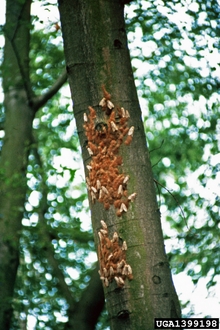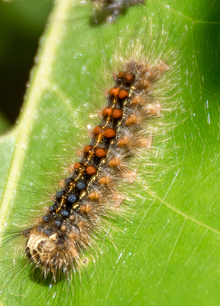Quick facts
Lymantria dispar is a quarantined invasive species. Items that could transport this insect may not be moved without permission from the Minnesota Department of Agriculture.
- Spongy moth* caterpillars are voracious feeders found eating tree leaves at night.
- They are adaptable and can feed on over 300 different species of trees and woody plants.
The Minnesota Department of Agriculture monitors this invasive species. Please report spongy moth at Arrest the Pest.
*A new common name for Lymantria dispar, spongy moth, replaced the prior name of this insect, gypsy moth, in 2022.
How to identify spongy moths
- Spongy moths (Lymantria dispar) as larvae, caterpillars can grow to two inches long and have five pairs of blue spots and six pairs of rusty red spots along their backs.
- Female moths are one to two inches long and do not fly.
- They have cream-colored wings with dark-brown zigzag markings.
- Males are smaller than females and are brownish-gray.
- They have similar markings on their wings and have feathered antennae.
Life cycle
- Eggs are laid in a fuzzy pale-yellow colored mass in late summer to early fall.
- Egg masses are laid on virtually any surface that offers protection, from bark crevices and the underside of branches to mailboxes and campers.
- Pupae are reddish-brown and leathery.
- Female pupae are larger than males.
- Adult moths emerge in mid-summer.
- Females emit a scent to attract male moths, this characteristic influences management.
- Spongy moths complete one life cycle per year.
Reviewed in 2022




